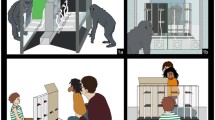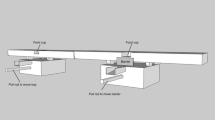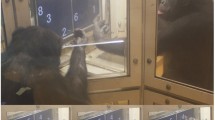Abstract
We presented two chimpanzees with a task in which they were required to pull each end of a rope simultaneously to drag blocks supporting food into reach. The chimpanzees did not succeed in initial tests. They did not immediately understand the necessity for cooperation, and they did not adjust their behavior to work with the partner. However, the frequency of success gradually increased as the number of sessions increased and the task was varied. They began to look at the partner frequently, wait if the partner was not holding the rope, and pull the rope in synchrony with the partner. However, they did not use interactive behaviors or eye contact to synchronize their behavior. One chimpanzee was then paired with a human partner in the same situation. After initial failures, the chimpanzee began to solicit the human partner for cooperation: looking up at his face, vocalizing, and taking the partner’s hand. When this chimpanzee was again paired with the chimpanzee partner, no soliciting behavior was observed. Thus, the chimpanzees could learn to coordinate their behavior through trial and error. Communicative behavior emerged during the task, but the communication differed according to the identity of the partner.





Similar content being viewed by others
References
Boesch C, Boesch H (1989) Hunting behavior of wild chimpanzees in the Tai National Park. Am J Phys Anthropol 78: 547–573
Call J, Tomasello M (1996) The effect of humans on the cognitive development of apes. In: Russon AE, Bard KA, Parker ST (eds) Reaching into thought: the minds of the great apes. Cambridge University Press, Cambridge, pp 371–403
Chalmeau R (1994) Do chimpanzees cooperate in a learning task? Primates 35:385–392
Chalmeau R, Gallo A (1996a) What chimpanzees (Pan troglodytes) learn in a cooperative task. Primates 37:39–47
Chalmeau R, Gallo A (1996b) Cooperation in primates: critical analysis of behavioral criteria. Behav Proc 35:101–111
Chalmeau R, Lardeux K, Brandibas P, Gallo A (1997a) Cooperative problem solving by orangutans (Pongo pygmaeus). Int J Primatol 18:23–32
Chalmeau R, Visalberghi E, Gallo A (1997b) Capuchin monkeys, Cebus apella, fail to understand a cooperation task. Anim Behav 54:1215–1225
Crawford MP (1937) The cooperative solving of problems by young chimpanzees. Comp Psychol Monogr 14:1–88
Garber P (1997) One for all and breeding for one: cooperation and competition as a tamarin reproductive strategy. Evol Anthropol 5:187–199
Gómez JC (1990) The emergence of intentional communication as a problem-solving strategy in the gorilla. In: Parker ST, Gibson KR (eds) “Language” and intelligence in monkeys and apes: comparative developmental perspectives. Cambridge University Press, New York, pp 333–355
Gómez JC (2004) Apes, monkeys, children, and growth of mind. Harvard University Press, Cambridge
Idani G, Hirata S (2006) Studies at the Great Ape Research Institute. In: Washburn DA (ed) Primate perspectives on behavior and cognition. American Psychological Association, Washington, pp 29–36
Melis AP, Hare B, Tomasello M (2006) Chimpanzees recruit the best collaborators. Science 311:1297–1300
Mendres KA, de Waal FBM (2000) Capuchins do cooperate: the advantage of an intuitive task. Anim Behav 60:523–529
Muroyama Y (1991) Mutual reciprocity of grooming in female Japanese macaques (Macaca fuscata). Behaviour 119:161–170
Povinelli DJ, O’Neill D (2000) Do chimpanzees use their gestures to instruct each other? In: Baron-Cohen S, Tager-Flusberg H, Cohen D (eds) Understanding other minds: perspectives from developmental cognitive neuroscience, 2nd edn. Oxford University Press, Oxford, pp 459–487
Tomasello M, Carpenter M, Call J, Behne T, Moll H (2005) Understanding and sharing intentions: the origins of cultural cognition. Behav Brain Sci 28:675–690
Acknowledgments
This study was financially supported by the Ministry of Education, Culture, Sports, Science and Technology, Japan (grant 1870266 to S. Hirata), the Sasagawa Scientific Research Grant from the Japan Science Society (grant 16–308 to S. Hirata), and the Core-to-Core Program HOPE by the Japan Society for the Promotion of Science. We thank S. Sekine, K. Sugama, and K. Kusunoki for assistance with data collection, and N. Morimura and G. Idani for support and suggestions. Thanks are also due to N. Sato, F. Kawashima, and T. Nanba for support in conducting the experiment and for caring for the chimpanzees. The chimpanzees were cared for according to the “Guide for the Care and Use of Laboratory Animals” of Hayashibara Biochemical Laboratories, Inc., and the guidelines laid down by the Primate Society of Japan.
Author information
Authors and Affiliations
Corresponding author
About this article
Cite this article
Hirata, S., Fuwa, K. Chimpanzees (Pan troglodytes) learn to act with other individuals in a cooperative task. Primates 48, 13–21 (2007). https://doi.org/10.1007/s10329-006-0022-1
Received:
Accepted:
Published:
Issue Date:
DOI: https://doi.org/10.1007/s10329-006-0022-1




